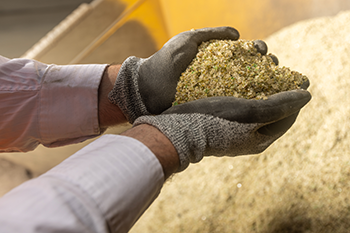Diverting glass from landfill to asphalt
Paving the way for glass recycling: promoting market development of recycled glass in asphalt.
Edge Environment Pty Ltd
Edge Environment received a grant of $40,800 through the Circulate NSW Industrial Ecology Program. The business diverted over 20,000 tonnes of glass away from landfill while trialling the use of recycled glass in infrastructure projects. Edge also developed an Environmental Product Declaration (EPD).

An EPD is an International Organization for Standardization (ISO) compliant, independent, transparent, third-party verified environmental label that presents the life cycle embodied carbon and other environmental impacts of a product in a standardised format. It was chosen for this project to incentivise the adoption of recycled glass asphalt on State Significant Infrastructure projects, such as Parramatta Light Rail.
Five asphalt mix designs were chosen for incorporation into the EPD. These mixes have different percentages of recycled glass and reclaimed asphalt pavement. Edge modelled the environmental impacts for the asphalt mixes through Life Cycle Assessment (LCA), working with partners to verify the results. In addition, Edge produced communications material in the form of a brochure to communicate the benefits of EPDs, including a case study on Parramatta Light Rail.
Results

Having a partner like Downer, both as a product manufacturer and a constructor that uses glass, not only supported the project but also contributed towards a greater material diversion from landfill. The EPA also played a major part. “The EPA can be the glue that joins together these sorts of projects with grant funding, and can bring the producer, the contractor and the end user together”, said Darren Crosser from Edge.
The numbers
- Circulate grant $40,800
- 20,959 tonnes glass diverted away from landfill
The benefits
- diversion of significant amount of glass away from landfill
- reduced need for virgin materials such as sand
- environmental Product Declaration enables adoption of better practices
- educational information builds knowledge enabling action


